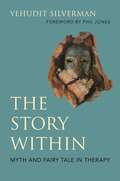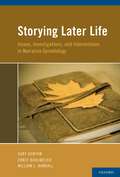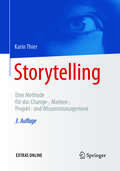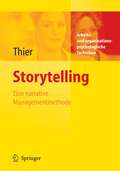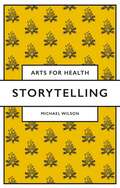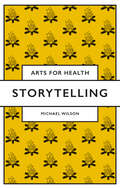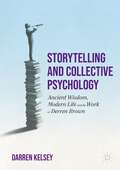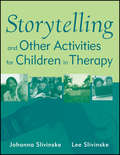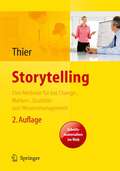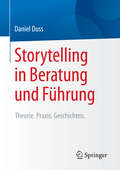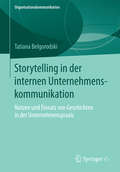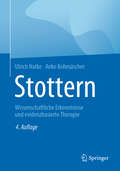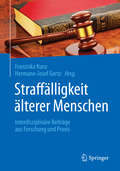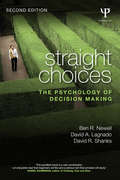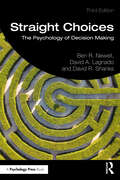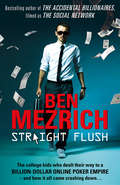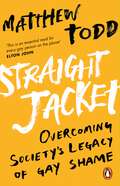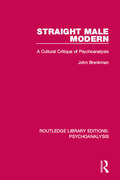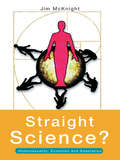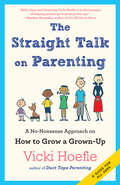- Table View
- List View
The Story Within - Myth and Fairy Tale in Therapy: Myth And Fairy Tale In Therapy
by Yehudit SilvermanSomewhere hidden in the depths of each story lies a treasure waiting to be discovered...This creative arts therapies approach uses myth and fairy tale to explore personal challenges. Clients begin by choosing a myth or fairy tale character they feel drawn to, but don't know why. They and their chosen character then embark on a guided creative journey that leads them to discover hidden, unconscious, aspects of themselves. The process is holistic, using all the arts. In addition to explaining the theoretical background of this approach, the book provides detailed step-by-step instructions for readers to follow for their own personal exploration, including specific creative exercises at each stage, and guidelines for using the approach with clients. Also included are clinical case vignettes, reflections from people who have experienced the process, and the authors own personal journey.Whether you are a creative arts therapist seeking to expand your practice, or a health professional searching for a new, creative way of working with clients, The Story Within is an exciting new resource.
Storying Later Life: Issues, Investigations, and Interventions in Narrative Gerontology
by Gary Kenyon Ernst Bohlmeijer William L. RandallIn its brief but vigorous history, gerontology has spawned a broadening range of specializations. One of the newest of such specializations is narrative gerontology, so named for its emphasis on the biographical, or inside, dimensions of the experience of aging. Telling stories about our world, our relationships, and ourselves is fundamental to how we make meaning. Everything from our history to our religion and our memories to our emotions is linked to the tales we tell ourselves, and others, about where we have come from and where we are going. They are central to who we are. The biographical side of human life is every bit as critical to fathom as the biological side, if we seek a more balanced, positive, and optimistic perspective on what aging is about; if we would honor the dignity and complexity, the humanity and uniqueness of the lives of older persons, no matter what their health or economic standing. In this respect, a narrative approach is particularly suited to the exploration of such topics as meaning, spirituality, and wisdom, and the connections they share. This volume reflects a selection of new directions and insights, and constitutes a general broadening and deepening of narrative gerontology, exploring its implications for theory and research in the field of aging, and for the quality of life of older adults themselves. Such deepening indicates a greater refinement of thought, method, and intervention. The evolution of narrative gerontology is also evidenced by a significant increase in the number of faculty and graduate students engaged in research in this area, as well as by increasing collaboration among researchers, practitioners, and administrators in applying narrative insights to contexts such as long term care - indeed, healthcare in general. These initiatives have given rise to the phrase, "narrative care as core care".
Storytelling: Eine Methode für das Change-, Marken-, Projekt- und Wissensmanagement (Arbeits- Und Organisationspsychologie Ser.)
by Karin ThierDieses Buch erklärt praxisnah, wie Storytelling, eine Methode des narrativen, auf Geschichten und Erzählungen beruhenden Wissensmanagements, in allen betrieblichen Handlungsfeldern - vom Qualitäts- über das Informations- bis zum Change Management - eingesetzt werden kann: Beteiligte werden zu abgeschlossenen Projekten befragt, die Antworten werden in leicht verständliche, spannende Geschichten verpackt - und so wird das im Unternehmen vorhandene Wissen genutzt, so kann aus erfolgreichen und weniger erfolgreichen Abläufen gelernt werden. - Für Wissensmanager, Personalleiter, Führungskräfte, Berater und Coaches.
Storytelling: Eine narrative Managementmethode
by Karin ThierNarratives Wissensmanagement – was ist das? Warum war das neu eingeführte Projekt ein Erfolg, ein anderes dagegen ein Fehlschlag? Was kann man aus erfolgreichen und weniger erfolgreichen Projekten und Abläufen lernen? Wie kann ich das im Unternehmen vorhandene Wissen nutzen, um zukünftig Zeit, Mühen und Kosten zu sparen? Das sind wichtige und kostenintensive Fragen des Wissensmanagements. Ein neuer Ansatz dabei ist das Story telling, eine Methode des narrativen, auf Geschichten und Erzählungen beruhenden Wissensmanagements. Durch Erzählen Wissen managen! Mittels Erzählungen von Beteiligten über besonders gut und besonders schlecht verlaufene Projekte wird eine Antwort auf diese Fragen gegeben. Das Unternehmen geht nicht zur Tagesordnung über, sondern lernt aus den Erfahrungen der Mitarbeiter. Die Antworten werden in leicht verständliche, nachvollziehbare, spannende Geschichten verpackt – nüchterne Inhalte werden so mit Leben gefüllt und eignen sich hervorragend, um Botschaften verständlich zu übermitteln. Methodisches Vorgehen mit Interviewtechniken und Handlungsanleitungen; Konstruktion der Geschichten, Vermittlung der Ergebnisse; Fallbeispiele aus großen und mittelständischen Unternehmen
Storytelling (Arts for Health)
by Michael WilsonExploring the potential for storytelling as a creative practice for health and well-being, Michael Wilson considers how the art form might help us reconsider the power relationships in healthcare contexts and restore agency to patients, in partnership with medical professionals. Storytelling is explored not simply as a means of conveying information and experience from one person to another but as an act of listening, a process for thinking, evaluating and understanding. Wilson reflects on his over thirty of years of researching and practising storytelling, and blends his experience with a collection of case studies representing diverse approaches to storytelling for health, including theatre, stand-up comedy, writing, visual arts and digital storytelling. Most importantly, storytelling is approached not from the point of view of the medical practitioner or educator, or even the patient, but through the lens of those who tell stories as a creative and everyday practice. It is a book with the storyteller at its core.
Storytelling (Arts for Health)
by Michael WilsonExploring the potential for storytelling as a creative practice for health and well-being, Michael Wilson considers how the art form might help us reconsider the power relationships in healthcare contexts and restore agency to patients, in partnership with medical professionals. Storytelling is explored not simply as a means of conveying information and experience from one person to another but as an act of listening, a process for thinking, evaluating and understanding. Wilson reflects on his over thirty of years of researching and practising storytelling, and blends his experience with a collection of case studies representing diverse approaches to storytelling for health, including theatre, stand-up comedy, writing, visual arts and digital storytelling. Most importantly, storytelling is approached not from the point of view of the medical practitioner or educator, or even the patient, but through the lens of those who tell stories as a creative and everyday practice. It is a book with the storyteller at its core.
Storytelling and Collective Psychology: Ancient Wisdom, Modern Life and the Work of Derren Brown
by Darren KelseyThis book examines the work of psychological illusionist Derren Brown to understand the significance of storytelling and ancient philosophy in our society. Reflecting on the social disconnection and political polarisation of recent times, Darren Kelsey considers how we can rebuild a sense of collective cohesion and common good, weaving together contemporary psychology with ancient Stoicism to cut through the noise of modern life. Kelsey shows that Brown is more than a stage performer: he’s an enlightened magician who offers us guidance for navigating the challenges life throws at us, using his skills and wisdom to help us better understand ourselves and enable human flourishing. In this rigorous examination of Brown’s work, Kelsey makes a compelling case for paying closer attention to our personal, cultural and political stories and beliefs to help create a better future – for ourselves, our communities, and the planet.
Storytelling and Other Activities for Children in Therapy
by Johanna Slivinske Lee SlivinskeA comprehensive collection of hundreds of thought-provoking stories and activities for use in the treatment of children confronting difficult situations Storytelling and Other Activities for Children in Therapy provides professionals with the knowledge, insight, and tools to help children (ages 6 to 12) and their families work through their treatment issues using storytelling and other activities. This invaluable guide includes helpful activity sheets that gradually progress through four levels of inquiry, representing readiness for self-disclosure. Imaginative and easy-to-use, the stories and activities in this book are tied to relevant practice issues, including: Illness and disability School issues Anger and behavioral issues Social adjustment and shyness Divorce and parental separation Domestic violence Community violence Trauma and child abuse Substance abuse Death With an accompanying website allowing therapists to personalize and print stories as well as activity sheets to meet their needs and those of their clients, Storytelling and Other Activities for Children in Therapy is an important tool in easing the pain of emotionally hurt children towards a discovery of their inner strengths and resilience for life. These resources can be accessed at www.wiley.com/go/slivinske.
Storytelling and Other Activities for Children in Therapy
by Johanna Slivinske Lee SlivinskeA comprehensive collection of hundreds of thought-provoking stories and activities for use in the treatment of children confronting difficult situations Storytelling and Other Activities for Children in Therapy provides professionals with the knowledge, insight, and tools to help children (ages 6 to 12) and their families work through their treatment issues using storytelling and other activities. This invaluable guide includes helpful activity sheets that gradually progress through four levels of inquiry, representing readiness for self-disclosure. Imaginative and easy-to-use, the stories and activities in this book are tied to relevant practice issues, including: Illness and disability School issues Anger and behavioral issues Social adjustment and shyness Divorce and parental separation Domestic violence Community violence Trauma and child abuse Substance abuse Death With an accompanying website allowing therapists to personalize and print stories as well as activity sheets to meet their needs and those of their clients, Storytelling and Other Activities for Children in Therapy is an important tool in easing the pain of emotionally hurt children towards a discovery of their inner strengths and resilience for life. These resources can be accessed at www.wiley.com/go/slivinske.
Storytelling. Eine Methode für das Change-, Marken-, Qualitäts- und Wissensmanagement
by Karin ThierStorytelling in Beratung und Führung: Theorie. Praxis. Geschichten.
by Daniel DussDieses Buch beleuchtet, warum Geschichten als Beratungsintervention ausgesprochen wirksam sind. Es gibt praktische Hinweise, wann und wie Geschichten eingesetzt werden können. Berater/innen und Führungskräfte können so mit ihren Erzählungen gezielt Entwicklungen initiieren und unterstützen. Praxisbeispiele und eine Sammlung kommentierter Kurzgeschichten, von Brecht bis Watzlawick, legen davon Zeugnis ab.
Storytelling in der internen Unternehmenskommunikation: Nutzen und Einsatz von Geschichten in der Unternehmenspraxis (Organisationskommunikation)
by Tatiana BelgorodskiTatiana Belgorodski untersucht erstmals das Erzählen von Geschichten, das Storytelling, mit Blick auf die interne Unternehmenskommunikation. Sie zeigt auf, wie Geschichten wirken und von welchen Einflussfaktoren ihr Nutzen für die interne (Change-)Kommunikation abhängt. Vor dem Hintergrund kognitions- und sozialpsychologischer Erkenntnisse werden Risiken und Chancen von Storytelling diskutiert, Interviews mit Unternehmensvertretern gewähren einen Einblick in die Praxis des Geschichtenerzählens in einem globalen Pharmaunternehmen. Die Autorin liefert eine umfassende Darstellung und Bewertung unterschiedlicher Storytelling-Beispiele und entwickelt ein Modell zum Einsatz und Nutzen des Storytellings für Kommunikationsmanagerinnen und -manager sowie Führungskräfte.
Stottern: Wissenschaftliche Erkenntnisse und evidenzbasierte Therapie
by Ulrich Natke Anke KohmäscherIn diesem Buch erhalten Sie einen Überblick über den wissenschaftlichen Stand und die aktuellen Behandlungsmethoden der Redeflussstörung Stottern. Die Häufigkeit von Stottern, Erscheinungsformen, Theorien zu den Ursachen, Diagnostik sowie Möglichkeiten der Therapie bei Kindern und Erwachsenen werden nachvollziehbar, praxisnah und auf dem neuesten Stand der Forschung dargestellt: Sprach- und Sprechstörungen, Epidemiologie und Phänomenologie, Entwicklungsverlauf und Variabilität, Ätiologie, Pathophysiologie, Diagnostik und TherapiemethodenDie Autoren engagieren sich in Lehre und Forschung und ermöglichen einen rationalen Zugang zu der verbreiteten Störung. Umfangreiche Literaturangaben ermöglichen eine vertiefende Lektüre in der Ausbildung und im Studium.Neu in der 4. Auflage: Komplett überarbeitet, aktualisiert und erweitert um folgende Themen: Mehrsprachigkeit, Exekutivfunktionen und Auswirkungen im Lebensverlauf stotternder Menschen. Das Buch ist für angehende wie für erfahrene Logopäden und Sprachtherapeuten unverzichtbar, die stotternde Menschen behandeln, und für Psychologen, Psychotherapeuten und Ärzte ein wertvolles Nachschlagewerk.bwiohih
Straffälligkeit älterer Menschen: Interdisziplinäre Beiträge aus Forschung und Praxis
by Franziska Kunz Hermann-Josef GertzStraffälligkeit älterer MenschenDas erste systematische und umfassende Buch ausschließlich zur Straffälligkeit älterer Menschen im deutschsprachigen Raum. Zu aktuellen Fragen rund um das Thema „Seniorenkriminalität“ werden durch jeweils einschlägig tätige Experten verschiedener Forschungs- und Praxisbereiche Erkenntnisse, Analysen und Perspektiven vorgestellt. Die Beiträge bieten damit in knapper Form einen aktuellen und facettenreichen Überblick zur Thematik. Das Buch eignet sich sowohl als Einstiegslektüre für eine ganzheitliche und vertiefte Auseinandersetzung mit dem Thema als auch als aussagekräftige Quelle zur gezielten Beschäftigung mit einzelnen Aspekten.Die Beiträge richten sich an ein breites Publikum: insbesondere an Wissenschaftler und Studierende der Fachrichtungen Soziologie, Kriminologie, Polizeiwissenschaft, Jura, Psychologie und (Geronto- sowie forensische) Psychiatrie, an Praktiker/Fachleute aus den Bereichen Soziale Arbeit und Kriminaljustiz (Polizisten, Juristen, JVA-Angestellte etc.) sowie an Journalisten und Publizisten.Aus dem Inhalt- Soziologische und kriminologische Aspekte- Juristische und kriminalpolitische Aspekte- Forensisch-psychiatrische Aspekte kriminellen Handelns von Senioren sowie Besonderheiten bei deren SchuldfähigkeitsbeurteilungDie HerausgeberDr. Franziska Kunz, Institut für Soziologie, Technische Universität DresdenProf. Dr. Hermann-Josef Gertz, Klinik und Poliklinik für Psychiatrie und Psychotherapie, Universitätsklinikum Leipzig
Straight Choices: The Psychology of Decision Making
by Ben R. Newell David A. Lagnado David R. ShanksShould I have this medical treatment or that one? Is this computer a better buy than that one? Should I invest in shares or keep my money under the bed? We all face a perplexing array of decisions every day. Thoroughly revised and updated throughout, the new edition of Straight Choices provides an integrative account of the psychology of decision-making, and shows how psychological research can help us understand our uncertain world. Straight Choices emphasises the relationship between learning and decision-making, arguing that the best way to understand how and why decisions are made is in the context of the learning and knowledge acquisition which precedes them, and the feedback which follows. The mechanisms of learning and the structure of environments in which decisions are made are carefully examined to explore their impact on our choices. The authors then consider whether we are all constrained to fall prey to cognitive biases, or whether, with sufficient exposure, we can find optimal decision strategies and improve our decision making. Featuring three completely new chapters, this edition also contains student-friendly overviews and recommended readings in each chapter. It will be of interest to students and researchers in cognitive psychology, behavioral economics, and the decision sciences, as well as anyone interested in the nature of decision making.
Straight Choices: The Psychology of Decision Making
by Ben R. Newell David A. Lagnado David R. ShanksShould I have this medical treatment or that one? Is this computer a better buy than that one? Should I invest in shares or keep my money under the bed? We all face a perplexing array of decisions every day. Thoroughly revised and updated throughout, the new edition of Straight Choices provides an integrative account of the psychology of decision-making, and shows how psychological research can help us understand our uncertain world. Straight Choices emphasises the relationship between learning and decision-making, arguing that the best way to understand how and why decisions are made is in the context of the learning and knowledge acquisition which precedes them, and the feedback which follows. The mechanisms of learning and the structure of environments in which decisions are made are carefully examined to explore their impact on our choices. The authors then consider whether we are all constrained to fall prey to cognitive biases, or whether, with sufficient exposure, we can find optimal decision strategies and improve our decision making. Featuring three completely new chapters, this edition also contains student-friendly overviews and recommended readings in each chapter. It will be of interest to students and researchers in cognitive psychology, behavioral economics, and the decision sciences, as well as anyone interested in the nature of decision making.
Straight Choices: The Psychology of Decision Making
by Ben R. Newell David A. Lagnado David R. ShanksStraight Choices provides a fascinating introduction to the psychology of decision making, enhanced by discussion of relevant examples of decision problems faced in everyday life. Thoroughly revised and updated throughout, this edition provides an integrative account of the psychology of decision-making and shows how psychological research can help us understand our uncertain world. The book emphasizes the relationship between learning and decision-making, arguing that the best way to understand how and why decisions are made is in the context of the learning and knowledge acquisition which precedes them, and the feedback which follows. The mechanisms of learning and the structure of environments in which decisions are made are carefully examined to explore their impact on our choices. The authors then consider whether we are all constrained to fall prey to cognitive biases, or whether, with sufficient exposure, we can find optimal decision strategies and improve our decision making. This edition highlights advances made in judgment and decision making research, with additional coverage of behavioral insights, nudging, artificial intelligence, and explanation-based decision making. Written in a non-technical manner, this book is an essential read for all students and researchers in cognitive psychology, behavioral economics, and the decision sciences, as well as anyone interested in the nature of decision making.
Straight Choices: The Psychology of Decision Making
by Ben R. Newell David A. Lagnado David R. ShanksStraight Choices provides a fascinating introduction to the psychology of decision making, enhanced by discussion of relevant examples of decision problems faced in everyday life. Thoroughly revised and updated throughout, this edition provides an integrative account of the psychology of decision-making and shows how psychological research can help us understand our uncertain world. The book emphasizes the relationship between learning and decision-making, arguing that the best way to understand how and why decisions are made is in the context of the learning and knowledge acquisition which precedes them, and the feedback which follows. The mechanisms of learning and the structure of environments in which decisions are made are carefully examined to explore their impact on our choices. The authors then consider whether we are all constrained to fall prey to cognitive biases, or whether, with sufficient exposure, we can find optimal decision strategies and improve our decision making. This edition highlights advances made in judgment and decision making research, with additional coverage of behavioral insights, nudging, artificial intelligence, and explanation-based decision making. Written in a non-technical manner, this book is an essential read for all students and researchers in cognitive psychology, behavioral economics, and the decision sciences, as well as anyone interested in the nature of decision making.
Straight Flush: The True Story Of Six College Friends Who Dealt Their Way To A Billion-dollar Online Poker Empire - And How It All Came Crashing Down...
by Ben MezrichStraight Flush is the true story of a group of University of Montana frat brothers who turned a weekly poker game in the basement of a local bar into one of the largest online poker companies in the world.At its height, the group's online empire was bringing in revenues of over a million dollars a day. The industry they launched grew so huge so fast, and in such a grey area of US and international law, at first it was never really clear whether their actions were legal or criminal. From setting up their operations in Costa Rica, to their efforts at building a veil of legitimacy in Vancouver; from embracing a hedonistic lifestyle of girls, drugs and money to becoming some of the richest people in the world; from engaging in operations against their competitors that sometimes escalated into near all-out wars to the legal battles that finally resulted in one of them heading to prison and another living life on the run – Straight Flush is an exclusive look behind the headlines of one of the biggest stories of the past decade.
Straight Jacket: Overcoming Society's Legacy Of Gay Shame
by Matthew Todd'This is an essential read for every gay person on the planet' - Elton JohnWINNER BOYZ BEST LGBT BOOK 2017SHORTLISTED FOR THE POLARI BOOK PRIZE 2017Straight Jacket is a revolutionary clarion call for gay men, the wider LGBT community, their friends and family. Part memoir, part ground-breaking polemic, it looks beneath the shiny facade of contemporary gay culture and asks if gay people are as happy as they could be – and if not, why not? Meticulously researched, courageous and life-affirming, Straight Jacket offers invaluable practical advice on how to overcome a range of difficult issues. It also recognizes that this is a watershed moment, a piercing wake-up-call-to-arms for the gay and wider community to acknowledge the importance of supporting all young people – and helping older people to transform their experience and finally get the lives they really want.
Straight Male Modern: A Cultural Critique of Psychoanalysis (Routledge Library Editions: Psychoanalysis)
by John BrenkmanMajor psychoanalytic thinkers from Freud to Ricoeur to Lacan considered the Oedipus complex the key to explaining the human psyche and human sexuality, even culture itself. But, in fact, they were merely theorizing males. In this title, originally published in 1993, the author reassesses the benchmark concepts of Freudian thought, building on feminist criticisms of psychoanalysis and the new history of sexuality. The psychoanalytic questions become political questions: How do the norms of heterosexuality and masculinity themselves emerge within modern society and culture? How do the institutions of compulsory heterosexuality and modern patriarchy shape identity and desire? What make heterosexuality compulsory in our society? Brenkman argues that the larger social world is part and parcel of the Oedipus complex. He challenges psychoanalysis to reinvent its cultural project, as a therapeutics and an ethics, by recovering the moral-political dimension in its approach to family, sexuality and gender. Straight Male Modern casts a new light on psychoanalysis’s contribution to modern life, revealing the richness of the Freudian tradition’s encounter with modern politics and culture, and the poverty of its response.
Straight Male Modern: A Cultural Critique of Psychoanalysis (Routledge Library Editions: Psychoanalysis)
by John BrenkmanMajor psychoanalytic thinkers from Freud to Ricoeur to Lacan considered the Oedipus complex the key to explaining the human psyche and human sexuality, even culture itself. But, in fact, they were merely theorizing males. In this title, originally published in 1993, the author reassesses the benchmark concepts of Freudian thought, building on feminist criticisms of psychoanalysis and the new history of sexuality. The psychoanalytic questions become political questions: How do the norms of heterosexuality and masculinity themselves emerge within modern society and culture? How do the institutions of compulsory heterosexuality and modern patriarchy shape identity and desire? What make heterosexuality compulsory in our society? Brenkman argues that the larger social world is part and parcel of the Oedipus complex. He challenges psychoanalysis to reinvent its cultural project, as a therapeutics and an ethics, by recovering the moral-political dimension in its approach to family, sexuality and gender. Straight Male Modern casts a new light on psychoanalysis’s contribution to modern life, revealing the richness of the Freudian tradition’s encounter with modern politics and culture, and the poverty of its response.
Straight Science? Homosexuality, Evolution and Adaptation: Homosexuality, Evolution And Adaptation
by Jim McKnightA genetic basis for homosexuality has been all but proved, yet Darwinism, the most widely accepted evolutionary theory, emphasises successful reproduction. How do we explain a lifetime preference for non-reproductive sex? Whilst social constructionism offers explanations in terms of social learning and cultural preferences, the body of evidence for a genetic predisposition to homosexuality grows. Social learning argues that homosexual sex is merely misdirected and therefore futile, but far from dying out it continues through the ages and is found in different cultures. What if there was an evolutionary advantage to homosexuality? Straight Science? Homosexuality, Evolution and Adaptation dares to ask such questions.
Straight Science? Homosexuality, Evolution and Adaptation
by Jim McKnightA genetic basis for homosexuality has been all but proved, yet Darwinism, the most widely accepted evolutionary theory, emphasises successful reproduction. How do we explain a lifetime preference for non-reproductive sex? Whilst social constructionism offers explanations in terms of social learning and cultural preferences, the body of evidence for a genetic predisposition to homosexuality grows. Social learning argues that homosexual sex is merely misdirected and therefore futile, but far from dying out it continues through the ages and is found in different cultures. What if there was an evolutionary advantage to homosexuality? Straight Science? Homosexuality, Evolution and Adaptation dares to ask such questions.
Straight Talk on Parenting: A No-Nonsense Approach on How to Grow a Grown-Up
by Vicki HoefleParents these days are under a great deal of pressure to be "perfect." From psychologists to social scientists, journalists to weekend bloggers, everyone has an opinion about the do's and don'ts for raising healthy, well-adjusted--and let's not forget, polite--children in today's fast-paced world. Where does this leave parents? Too often, lacking in confidence, ill equipped, and overwhelmed. Parenting expert Vicki Hoefle makes the bold claim that it's time for parents to get off the perfection path and get back to the real job of parenting: to grow a grown-up. In this no-nonsense parenting guide, Hoefle draws upon twenty-five years of experience with helping parents see the big picture and sidestep what she calls the "detail drama" that too often trumps everyday life with our kids. Parents learn more than just strategies; they learn a methodology that allows them to help their toddlers build a strong foundation for success in adulthood. In her trademark, tell-it-like-it-is style, Hoefle tells parents to trust their intuition and develop an intentional strategy for meeting each child's unique needs. Above all, The Straight Talk on Parenting offers the confidence-boosting reminder that parenting is about practice (and a healthy dose of humor), not perfection.
